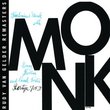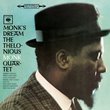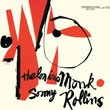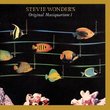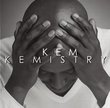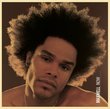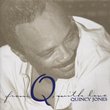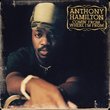| All Artists: Thelonious Monk Title: Thelonious Monk Trio: Rudy Van Gelder Remasters Members Wishing: 4 Total Copies: 0 Label: Prestige Original Release Date: 1/1/2007 Re-Release Date: 5/1/2007 Album Type: Original recording remastered Genres: Jazz, Pop Style: Bebop Number of Discs: 1 SwapaCD Credits: 1 UPC: 888072301641 |
Search - Thelonious Monk :: Thelonious Monk Trio: Rudy Van Gelder Remasters
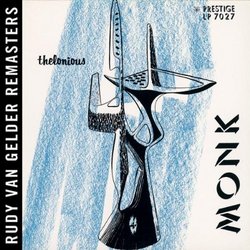 | Thelonious Monk Thelonious Monk Trio: Rudy Van Gelder Remasters Genres: Jazz, Pop
REMASTERED |
Larger Image |
CD DetailsSynopsis
Product Description REMASTERED Similar CDs
Similarly Requested CDs
|
CD ReviewsThe Purist's Monk Gordon M. Brown | San Diego, CA USA | 03/23/2009 (5 out of 5 stars) "Face it--if you're not predisposed to liking the compositions and/or piano stylings of Thelonious Monk, you're not going to buy this album anyway. But since you're on this webpage, it's presumed that either you haven't heard much of Monk if any, and are curious to investigate; or you already have some Monk in your collection and are wondering whether this distillation of Monk into trio form is worth your investment. On both counts, I say there is no question. And if you're new to Monk, it's hard to think of a better starting-point than this album. Recorded over three different sessions from '52 to '54, and under three different producers, this is also a collection of several permutations of the trio featuring either Gary Mapp or Percy Heath on bass, and either Art Blakey or Max Roach on drums. So why does this album charm so? Many reasons. One is that the trio format provides a true distillation of the Monk sound, with both bassists and drummers lending very fine, understanding support. (Blakey's contribution to "Bye-Ya" is particularly outstanding. Also, don't get me wrong--I think Monk's collaboration with Coltrane at Carnegie Hall in 1957 is one of the finest jazz albums ever recorded. But to my mind that album is really about Coltrane's sudden growth spurt under Monk's mentorship, within the context of one of the greatest bands Monk ever assembled.) Two, even though he had already been making waves for some seven years or so, this is very much a Monk captured early in his career. Three, many of Monk's signature tunes are offered here for the first time: "Blue Monk," "Bemsha Swing," "Reflections," "Little Rootie Tootie," "Bye-Ya," "Monk's Dream," and "Trinkle Tinkle." Four, "Just a Gigolo," one of three standards on the set, is a beautiful and poignant--almost tearful--solo performance by Monk, made even more bittersweet with his stride-style playing. Five, this album captures brilliantly the fact that Monk assimilated piano styles from many different jazz eras and mixed them together rather promiscuously, very nearly achieving a depiction of jazz as a type of American folk art. (In that regard see the note below about the out-of-tune piano on one of the sessions.) Six, the quality of the remaster is simply astonishing. You'll be hard-pressed to tell that these recordings were made almost sixty years ago. (I wish Rudy Van Gelder always got the remastering business this right.) If all that weren't enough, this album has some of the coolest jacket art around, a drawing by Gil Melle in what appears to be India ink, crayon, and press-on type, depicting an Isamu Noguchi-like piece of Atomic-Age sculpture. (That was definitely a tipping point for me. Jacket art matters!) Yeah, on some of the tracks you can definitely hear Monk nattering and singing rather loudly as he plays. But that's just Monk; you take it or leave it. Yeah, the piano was out-of-tune on one of the sessions, but somehow the peculiar sound only adds to the proceedings. It was a wise decision for all concerned not to worry about it. Open-minded Monk novitiates, Monk experts, and all else in between will find a lot to like in this album. Very strongly recommended. " The high priest of bebop G B | Connecticut | 04/27/2008 (5 out of 5 stars) "Thelonious Monk could really shine in the trio setting, where his unflagging creativity and memorable tunes could occupy the spotlight. These ten selections from '52 to '54 showcase that side of Monk wonderfully; and almost all of them are brief (less than 4 minutes), providing bite-sized intros to a nice chunk of his material. As a bonus, the drummers (Art Blakey or Max Roach) understand Monk's conception perfectly. Three of the tunes feature Monk's idiosyncratic playing on standards ("Sweet and Lovely", "These Foolish Songs", and the solo feature "Just a Gigolo"). The other seven are recording debuts of songs that would become jazz standards -- "Monk's Dream", "Little Rootie Tootie", "Trinkle Tinkle", etc. And the definite highlight is "Blue Monk", Monk's unforgettable blues (duh), where he gets to stretch out over 8 minutes with Blakey egging him on. Monk is often described as a "difficult" pianist due to his angular playing, but listeners often identify with his quirky-yet-catchy tunes and wry sense of humor. This (along with Volumes 1 and 2 of the Genius of Modern Music series on Blue Note) is the perfect introduction to the man and his music, as well as to jazz piano in general. [This review is based on the K2 20-bit remaster, which has fantastic sound. I have not heard the 2007 reissue. Both have identical tracklists.]" Gotta love "Blue Monk" J. Green | Los Angeles, California | 05/08/2008 (4 out of 5 stars) "I'm new to jazz and don't know squat about composition, but I'd never heard much that I truly liked. I tried a few artists and even "Meditations" by Coltrane, but it wasn't my thing either. But there's one song on the movie soundtrack "That Thing You Do!" by a fictional Del Paxton that I absolutely love - just piano, drums, bass, and I think guitar - and I've been trying to find similar music ever since. This CD came to my attention, and having heard some Monk-music before and listening to the samples, I decided to give it a try. It's not Del Paxton, but pretty close.
I especially love "Blue Monk," and "Bye-Ya" is another favorite. Many of the songs on the album have a very familiar sound, like I've heard the tune somewhere else, and I love the simple piano/bass/drums sound of the songs, and the way they're both up-beat and relaxing at the same time. My only negative would be the tone of the piano, which sometimes sounds a bit shrill to me, but I'm certainly no expert on how it should sound. It's especially prominent in "Little Rootie Tootie," which indeed sounds like a train. There is also some strange noises in the background on a few tracks, but I can't tell if it's from the band or not. But overall, a great jazz CD that I've been getting a lot of use out of. " |

 Track Listings (10) - Disc #1
Track Listings (10) - Disc #1